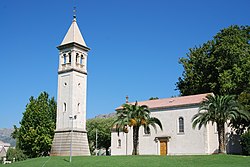
Back Солін Byelorussian Солін BE-X-OLD Солин Bulgarian Solin BS Solin CEB سۆلین CKB Solin Czech Solin Danish Solin German Solin Estonian
Solin | |
|---|---|
| Grad Solin Town of Solin | |
 | |
 | |
| Coordinates: 43°32′06″N 16°29′06″E / 43.535°N 16.485°E | |
| Country | |
| County | |
| Government | |
| • Mayor | Dalibor Ninčević (HDZ) |
| • City Council President | Dr. Zdravko Perko (HDZ) |
| • City Council name | Gradsko Vijeće |
| • No. of Council members | 19 |
| Area | |
| • Town | 34.2 km2 (13.2 sq mi) |
| • Urban | 11.4 km2 (4.4 sq mi) |
| Elevation | 0 m (0 ft) |
| Population (2021)[2] | |
| • Town | 24,862 |
| • Density | 730/km2 (1,900/sq mi) |
| • Urban | 20,996 |
| • Urban density | 1,800/km2 (4,800/sq mi) |
| Postal code | 21 210 |
| Area code | +385 (0)21 |
| Vehicle registration | ST |
| Website | solin |
Solin (Latin and Italian: Salona; Ancient Greek: Σαλώνα Salóna) is a town and a suburb of Split, in Split-Dalmatia county, Croatia. It is situated right northeast of Split, on the Adriatic Sea and the river Jadro.
Solin developed on the location of ancient city of Salona, which was the capital of the Roman province of Dalmatia and the birthplace of Emperor Diocletian. After the arrival of Avars and Croats[3] in the 7th-century, the town was destroyed, and its refugees moved to the settlement in and around Diocletian's palace, "Spalatum" (Split), turning it into a fortified town. In the Early Middle Ages, Solin was part of Croatian territory and played an important role in the Medieval Croatian state, being one of the political centres.
In the 20th century, the intensive industrialisation process of the Split basin made Solin no more than a suburb of Split. Today, with its independent municipal status, Solin is part of the Split conurbation, well connected with other towns. Lately, besides industry, tourism is being developed based on numerous archaeological sites and Solin's distinctive image that comes from many urban parks along the Jadro.
- ^ Register of spatial units of the State Geodetic Administration of the Republic of Croatia. Wikidata Q119585703.
- ^ "Population by Age and Sex, by Settlements" (xlsx). Census of Population, Households and Dwellings in 2021. Zagreb: Croatian Bureau of Statistics. 2022.
- ^ A History of the Croatian by Francis Ralph Preveden,1955
© MMXXIII Rich X Search. We shall prevail. All rights reserved. Rich X Search

